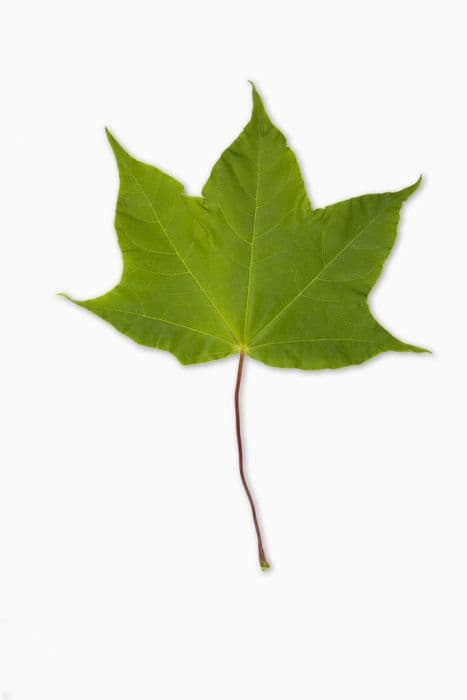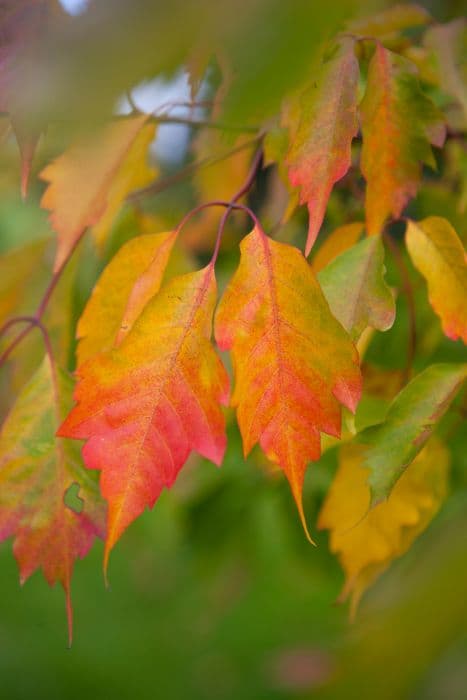Japanese Maple Acer palmatum 'Chitose-yama' (M)

ABOUT
The Japanese maple known as 'Chitose-yama' is a striking ornamental plant best known for its captivating leaf colors and elegant form. It displays a canopy of deeply lobed leaves, whose shapes resemble the palm of a hand with outstretched fingers. Each leaf typically exhibits a rich, plum-purple color that can transition to bright crimson and fiery shades of red as the seasons change, providing a spectacular display of color. The leaves are fine and delicate, forming a soft, feathery silhouette that adds a textural contrast to the garden. In spring, the new foliage may emerge in lighter tones of red or even with hints of green, and these leaves mature to achieve their distinctive deep purple coloration. During the fall, the foliage transitions again, taking on brilliant red hues that stand out in the landscape. The Japanese maple 'Chitose-yama' carries a gracefully branching structure, presenting its foliage on arching limbs that contribute to its overall aesthetic appeal. Though not a focal point, the plant may also produce small reddish-purple flowers which can add an extra touch of interest during the blooming season.
About this plant
 Names
NamesFamily
Sapindaceae
Synonyms
Chitose-yama Japanese Maple
Common names
Acer palmatum 'Chitose-yama'
 Toxicity
ToxicityTo humans
Japanese Maple is generally not considered toxic to humans. There are no widespread reports of serious toxicity in humans arising from ingesting or touching parts of the Japanese Maple. However, as with any plant material, individuals could potentially experience an allergic reaction or mild gastrointestinal upset if leaves or seeds are ingested in large quantities. It is always wise to avoid consuming plant parts unless they are known to be safe and are intended for culinary use.
To pets
Japanese Maple is not known to be toxic to dogs, cats, or other pets. It is not typically associated with serious health issues if pets ingest parts of the tree. While it's still not advisable for pets to consume plant material indiscriminately, there are no specific toxins in Japanese Maple that are known to cause symptoms of poisoning in common pets. Owners should still monitor their pets to prevent them from eating large quantities of any non-food plants, which can potentially cause digestive upset or blockages.
 Characteristics
CharacteristicsLife cycle
Perennials
Foliage type
Deciduous
Color of leaves
Mixed
Height
8 feet (2.44 meters)
Spread
6 feet (1.83 meters)
Plant type
Tree
Hardiness zones
5
Native area
Japan
Benefits
 General Benefits
General Benefits- Ornamental Value: The Japanese Maple 'Chitose-yama' offers beautiful foliage with a color range from deep purple to crimson red, making it a striking addition to any landscape.
- Seasonal Interest: Provides visual interest across multiple seasons, with spring blooms, vibrant fall color, and an elegant branching structure in the winter.
- Shade Tolerance: This cultivar is capable of growing in partial shade, offering flexibility in garden design and plant placement.
- Compact Size: Typically remains small, making it ideal for residential gardens and areas with limited space.
- Habitat for Wildlife: Attracts birds and beneficial insects, which enhance biodiversity and ecosystem health.
- Low Maintenance: Requires minimal upkeep beyond regular watering and occasional pruning, suitable for busy homeowners.
- Drought Resistance: Once established, it can tolerate periods of dry conditions, reducing the need for frequent watering.
- Cold Tolerance: Hardy in many climates and can withstand cold temperatures, making it a reliable choice for temperate gardens.
 Medical Properties
Medical PropertiesThis plant is not used for medical purposes.
 Air-purifying Qualities
Air-purifying QualitiesThis plant is not specifically known for air purifying qualities.
 Other Uses
Other Uses- Acer palmatum 'Chitose-yama', commonly known as Japanese Maple, can be used in bonsai cultivation due to its attractive foliage and branching structure.
- Japanese Maple can serve as a subject for photography and painting, especially during autumn when the leaves turn bright crimson.
- The wood of the Japanese Maple is occasionally used in woodworking for small projects like jewelry boxes or ornamental objects, thanks to its fine grain.
- Leaves of the Japanese Maple can be included in floral arrangements or pressed and used in craft projects for their aesthetic appeal.
- As Japanese Maples are symbolically connected to peace and serenity, they are often planted in memorial gardens and spaces of reflection.
- These trees are sometimes used in educational settings to teach about plant life cycles, botany, and horticulture practices.
- Japanese Maple can act as a natural privacy screen or windbreak in a garden setting when planted in groups.
- The plant is occasionally used in small urban or container gardens due to its ability to thrive with limited soil space.
- Japanese Maple's distinctive leaf shapes are sometimes used in design and architecture as a decorative motif or inspiration.
- The plant might be used in fantasy or theatrical settings due to its magical appearance, enhancing the ambiance of fairy tales or mystical themes.
Interesting Facts
 Feng Shui
Feng ShuiThe Japanese Maple is not used in Feng Shui practice.
 Zodiac Sign Compitability
Zodiac Sign CompitabilityThe Japanese Maple is not used in astrology practice.
 Plant Symbolism
Plant Symbolism- Change and Transition: The Japanese Maple, specifically 'Chitose-yama', with its changing leaf colors throughout the seasons, symbolizes the ephemeral nature of life and the beauty found in transitioning states.
- Calmness: The serene appearance of the Japanese Maple, with its delicate leaves and branches, often represents peace and tranquility, inviting contemplation and reflection.
- Great Blessings: In Japanese culture, maples are sometimes associated with blessings and positive fortunes, possibly due to their graceful form and vibrant colors.
- Balance: The balanced and symmetrical growth pattern of the Japanese Maple can symbolize harmony and equilibrium in life.
- Endurance: Despite their seemingly delicate appearance, Japanese Maples are hardy trees that can withstand various conditions, symbolizing endurance and inner strength.
 Water
WaterThe Japanese Maple 'Chitose-yama' prefers regular watering to maintain moist but not saturated soil, especially during dry spells. It should be watered deeply once a week, providing approximately 1.5 gallons for smaller trees and up to 4 gallons for larger mature specimens. Watering should be done slowly to allow the water to penetrate the soil and reach the roots rather than running off. During the growing season in spring and summer, young trees may need additional water, while established trees can be more drought tolerant. Always check the soil moisture before watering to avoid overwatering, which can lead to root rot.
 Light
LightJapanese Maple 'Chitose-yama' thrives in a location with partial shade to full sun. The ideal spot should offer protection from harsh afternoon sunlight, which can scorch the delicate leaves. However, it also requires enough light to bring out the vibrant colors of the foliage, thus a spot with morning sun and afternoon shade is often optimal. Dappled sunlight throughout the day is also beneficial for the balanced growth and health of the tree.
 Temperature
TemperatureJapanese Maple 'Chitose-yama' can tolerate a range of temperatures and is hardy in USDA zones 5 through 8. The ideal temperature range for this cultivar is between 60°F and 80°F. It can survive minimum winter temperatures down to -20°F once established. Extreme high temperatures over 90°F, particularly with direct sun exposure, can stress the tree and cause leaf burn, so providing some shade during the hottest part of the day is advantageous.
 Pruning
PruningPrune Japanese Maple 'Chitose-yama' to maintain its shape, remove any dead or diseased branches, and to encourage healthy growth. The best time to prune is during the late fall to winter when the tree is dormant, which minimizes stress and sap loss. Light pruning can be done in summer if necessary to enhance the tree's natural form. Only prune as needed, typically every 2 to 3 years, to avoid excessive cutting which can weaken the tree.
 Cleaning
CleaningAs needed
 Soil
SoilJapanese Maple 'Chitose-yama' thrives in well-drained, consistently moist soil with a high organic matter content. A mix of 1/3 peat, 1/3 pine bark, and 1/3 coarse sand or perlite is ideal. The preferred soil pH for this cultivar should be slightly acidic, around 5.5 to 6.5.
 Repotting
RepottingJapanese Maples, including the 'Chitose-yama' variety, should generally be repotted every 2 to 3 years to ensure they are not becoming root-bound and to replenish the nutrients in their soil.
 Humidity & Misting
Humidity & MistingThe Japanese Maple 'Chitose-yama' does well in average outdoor humidity levels but appreciates some protection from harsh wind, which can dry out the foliage. It doesn't require overly high humidity.
 Suitable locations
Suitable locationsIndoor
Grow in bright, indirect light with cool temp and high humidity.
Outdoor
Plant in partial shade, protect from harsh winds, and mulch well.
Hardiness zone
5-8 USDA
 Life cycle
Life cycleAcer palmatum 'Chitose-yama', commonly known as Japanese maple, begins its life cycle when its seeds germinate in spring, provided they've undergone stratification to break dormancy. Seedlings emerge and enter a juvenile phase, characterized by rapid growth and development of the plant's distinctive palmate leaves, which display a range of colors from green to burgundy. As the Japanese maple matures, it enters its vegetative stage, with slower growth rates and the development of a woody stem structure, allowing the tree to reach heights of 6-10 feet. This is followed by the reproductive stage, where small, inconspicuous flowers bloom in spring, typically unnoticed due to the prominence of the foliage. After pollination, the flowers give way to samaras, winged fruits that disperse with the wind, ensuring propagation of the species. The life cycle of a Japanese maple may end due to various factors such as extreme weather conditions, disease, or old age, which could be several decades long under optimal conditions.
 Propogation
PropogationPropogation time
Late winter
The Japanese maple 'Chitose-yama' is most commonly propagated through softwood cuttings taken early in the growing season, around late spring to early summer. To do this, a healthy shoot approximately 4 to 6 inches long is selected and cut just below a leaf node. The leaves at the lower half of the cutting are removed, and the cut end is dipped in rooting hormone to stimulate root growth. The prepared cutting is then placed in a well-draining potting mix, and the environment is kept humid by covering it with a plastic bag or placing it in a propagation chamber. The cutting should be kept out of direct sunlight but in a bright, indirect light area with a consistent temperature of about 68 to 77 degrees Fahrenheit (20 to 25 degrees Celsius). Roots typically begin to develop within a few weeks, after which the new plant can be gradually acclimatized to less humid conditions before being transplanted outdoors.









